TOYOTA MIRAI 2020 Owners Manual (in English)
Manufacturer: TOYOTA, Model Year: 2020, Model line: MIRAI, Model: TOYOTA MIRAI 2020Pages: 528, PDF Size: 11.98 MB
Page 261 of 528
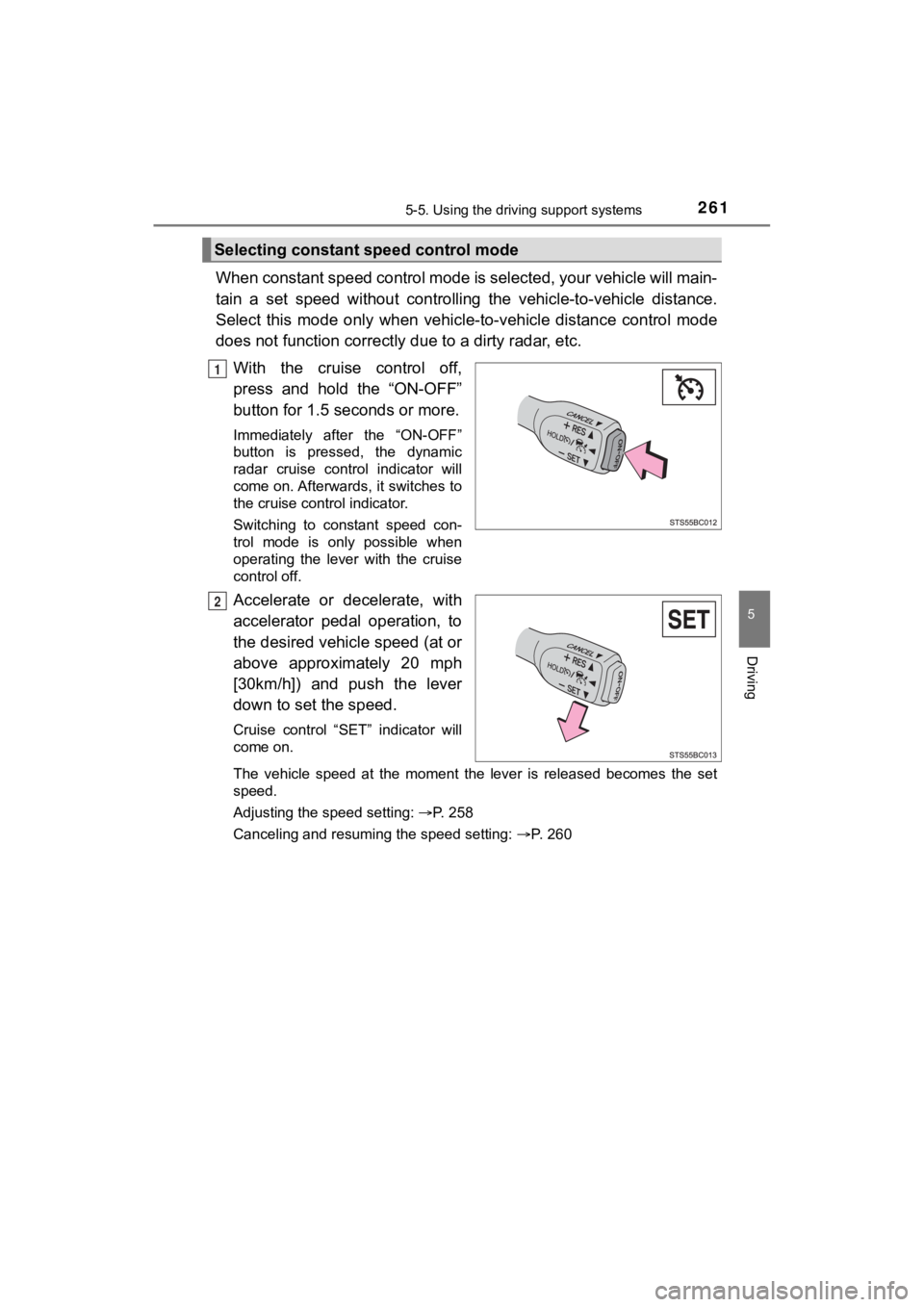
2615-5. Using the driving support systems
5
Driving
MIRAI_OM_USA_OM62073U
When constant speed control mode is selected, your vehicle will main-
tain a set speed without controllin g the vehicle-to-vehicle distance.
Select this mode only when vehic le-to-vehicle distance control mode
does not function correctly due to a dirty radar, etc.
With the cruise control off,
press and hold the “ON-OFF”
button for 1.5 seconds or more.
Immediately after the “ON-OFF”
button is pressed, the dynamic
radar cruise control indicator will
come on. Afterwards, it switches to
the cruise control indicator.
Switching to constant speed con-
trol mode is only possible when
operating the lever with the cruise
control off.
Accelerate or decelerate, with
accelerator pedal operation, to
the desired vehicle speed (at or
above approximately 20 mph
[30km/h]) and push the lever
down to set the speed.
Cruise control “SET” indicator will
come on.
The vehicle speed at the moment the lever is released becomes the set
speed.
Adjusting the speed setting: P. 258
Canceling and resuming the speed setting: P. 260
Selecting constant speed control mode
1
2
Page 262 of 528

2625-5. Using the driving support systems
MIRAI_OM_USA_OM62073U
■Dynamic radar cruise control can be set when
●The shift position is in D.
● Depending on the control mode, this item can be set at the foll owing
speeds.
• Vehicle-to-vehicle distance c ontrol mode: Approximately 20 mph (30 km/h)
or more
• Constant speed control mode: Approximately 20 mph (30 km/h) or more
■ Accelerating after setting the vehicle speed
The vehicle can accelerate by operating the accelerator pedal. After acceler-
ating, the set speed resumes. However, during vehicle-to-vehicl e distance
control mode, the vehicle speed may decrease below the set spee d in order
to maintain the distance to the preceding vehicle.
■ Automatic cancelation of vehicle-to-vehicle distance control mode
Vehicle-to-vehicle distance control mode is automatically cance led in the fol-
lowing situations.
● Actual vehicle speed falls below approximately 16 mph (25 km/h) .
● VSC is activated.
● TRAC is activated for a period of time.
● When the VSC or TRAC system is turned off.
● The sensor cannot detect correctly because it is covered in some way.
● Pre-collision braking is activated.
If vehicle-to-vehicle distance control mode is automatically ca nceled for any
reasons other than the above, there may be a malfunction in the system.
Contact your Toyota dealer.
■ Automatic cancelation of c onstant speed control mode
Constant speed control mode is automatically canceled in the following situa-
tions:
● Actual vehicle speed is more than approximately 10 mph (16 km/h ) below
the set vehicle speed.
● Actual vehicle speed falls below approximately 20 mph (30 km/h) .
● VSC is activated.
● TRAC is activated for a period of time.
● When the VSC or TRAC system is turned off.
● Pre-collision braking is activated.
If constant speed control mode is automatically canceled for any reasons
other than the above, there may be a malfunction in the system. Contact your
Toyota dealer.
■ Brake operation
A brake operation sound may be heard and the brake pedal response may
change, but these are not malfunctions.
Page 263 of 528
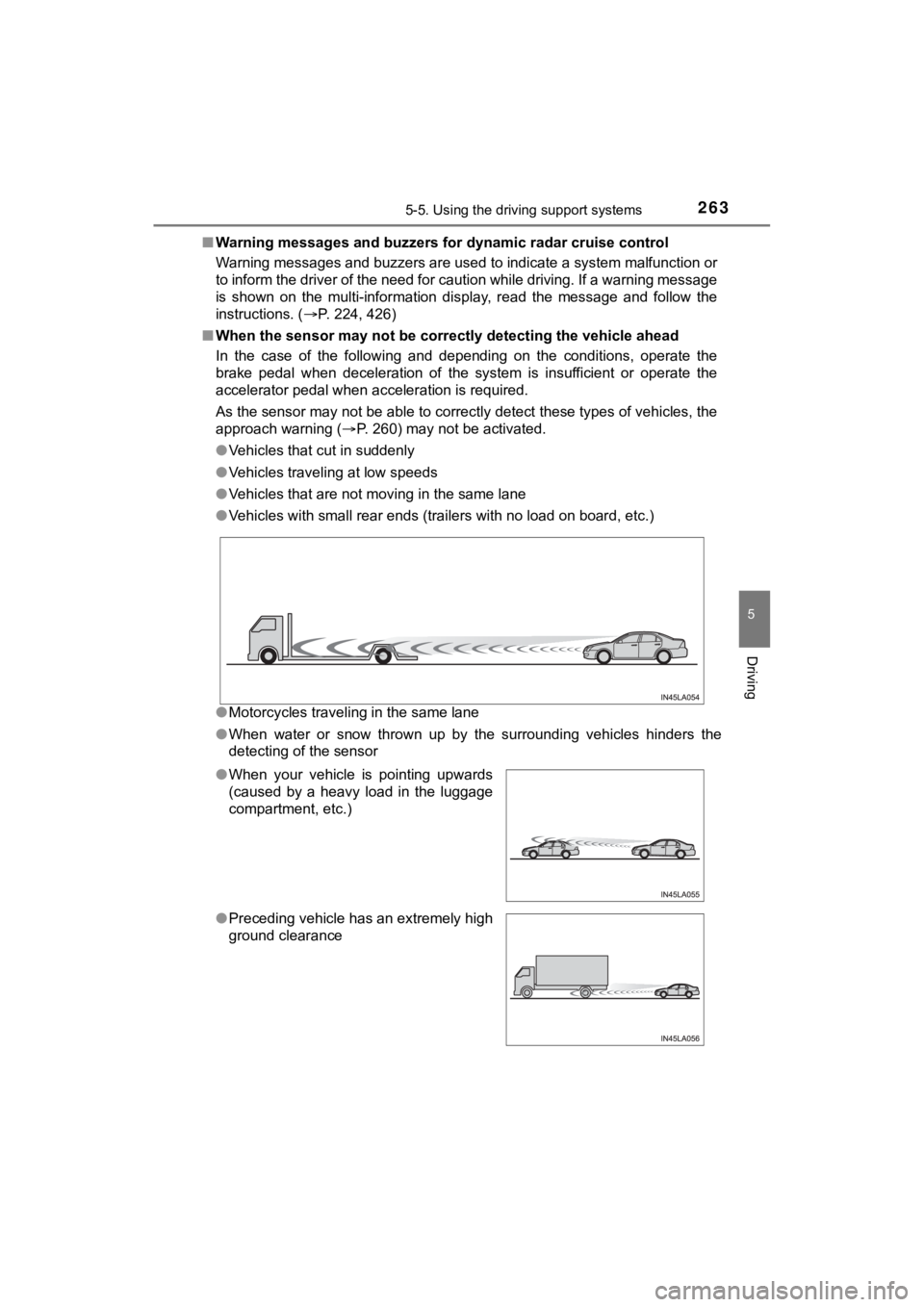
2635-5. Using the driving support systems
5
Driving
MIRAI_OM_USA_OM62073U■
Warning messages and buzzers for d ynamic radar cruise control
Warning messages and buzzers are used to indicate a system malfunction or
to inform the driver of the need for caution while driving. If a warning message
is shown on the multi-information display, read the message and follow the
instructions. ( P. 224, 426)
■ When the sensor may not be correctly detect ing the vehicle ahead
In the case of the following and depending on the conditions, o perate the
brake pedal when deceleration of the system is insufficient or operate the
accelerator pedal when acceleration is required.
As the sensor may not be able to correctly detect these types o f vehicles, the
approach warning ( P. 260) may not be activated.
● Vehicles that cut in suddenly
● Vehicles traveling at low speeds
● Vehicles that are not moving in the same lane
● Vehicles with small rear ends (trailers with no load on board, etc.)
● Motorcycles traveling in the same lane
● When water or snow thrown up by the surrounding vehicles hinders the
detecting of the sensor
● When your vehicle is pointing upwards
(caused by a heavy load in the luggage
compartment, etc.)
● Preceding vehicle has an extremely high
ground clearance
Page 264 of 528
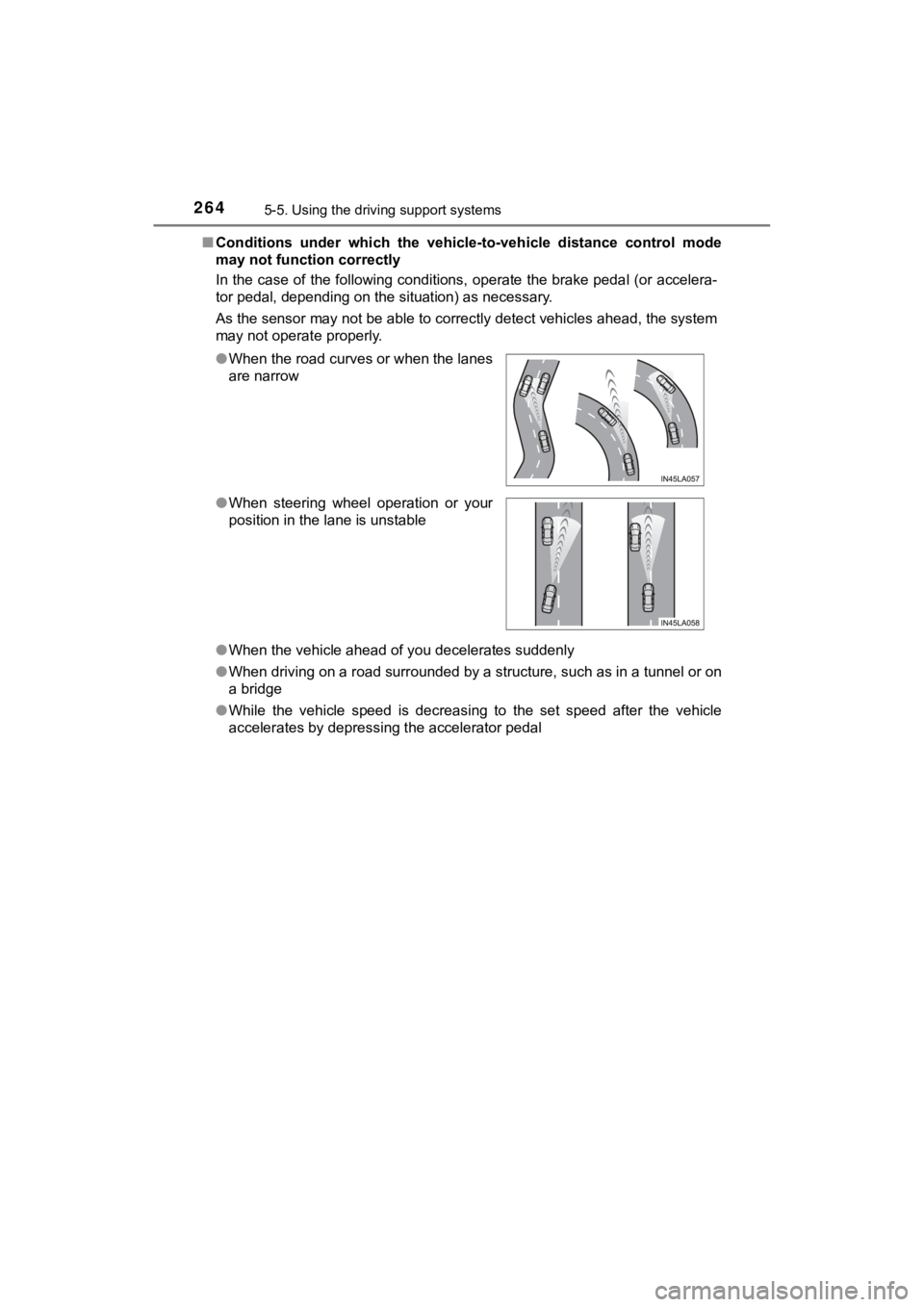
2645-5. Using the driving support systems
MIRAI_OM_USA_OM62073U■
Conditions under which the vehic le-to-vehicle distance control mode
may not function correctly
In the case of the following conditions, operate the brake peda l (or accelera-
tor pedal, depending on the situation) as necessary.
As the sensor may not be able to correctly detect vehicles ahead, the system
may not operate properly.
● When the vehicle ahead of you decelerates suddenly
● When driving on a road surrounded by a structure, such as in a tunnel or on
a bridge
● While the vehicle speed is decreasing to the set speed after th e vehicle
accelerates by depressing the accelerator pedal
●
When the road curves or when the lanes
are narrow
● When steering wheel operation or your
position in the lane is unstable
Page 265 of 528
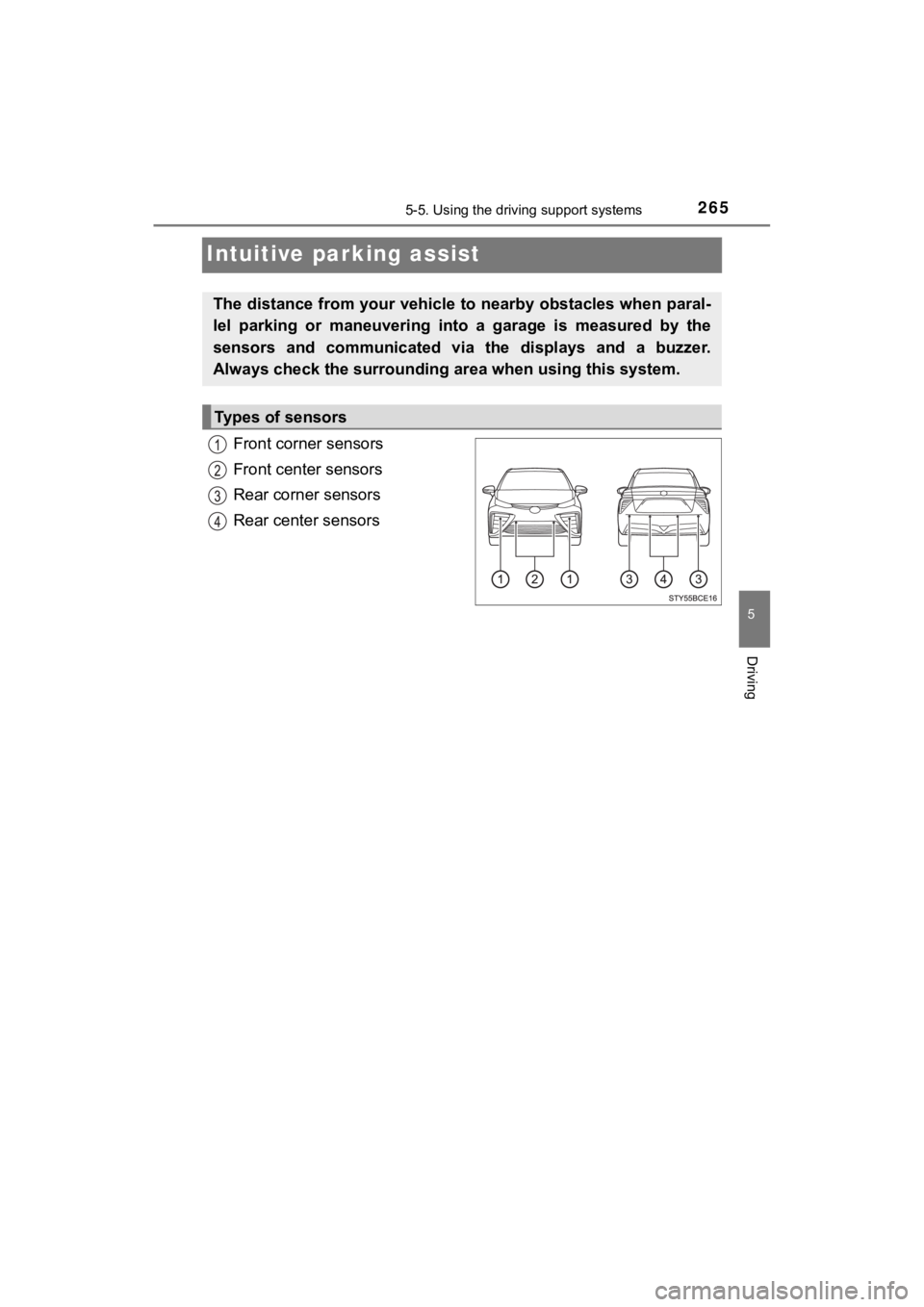
2655-5. Using the driving support systems
5
Driving
MIRAI_OM_USA_OM62073U
Intuitive parking assist
Front corner sensors
Front center sensors
Rear corner sensors
Rear center sensors
The distance from your vehicle to nearby obstacles when paral-
lel parking or maneuvering into a garage is measured by the
sensors and communicated via the displays and a buzzer.
Always check the surrounding ar ea when using this system.
Types of sensors
Page 266 of 528
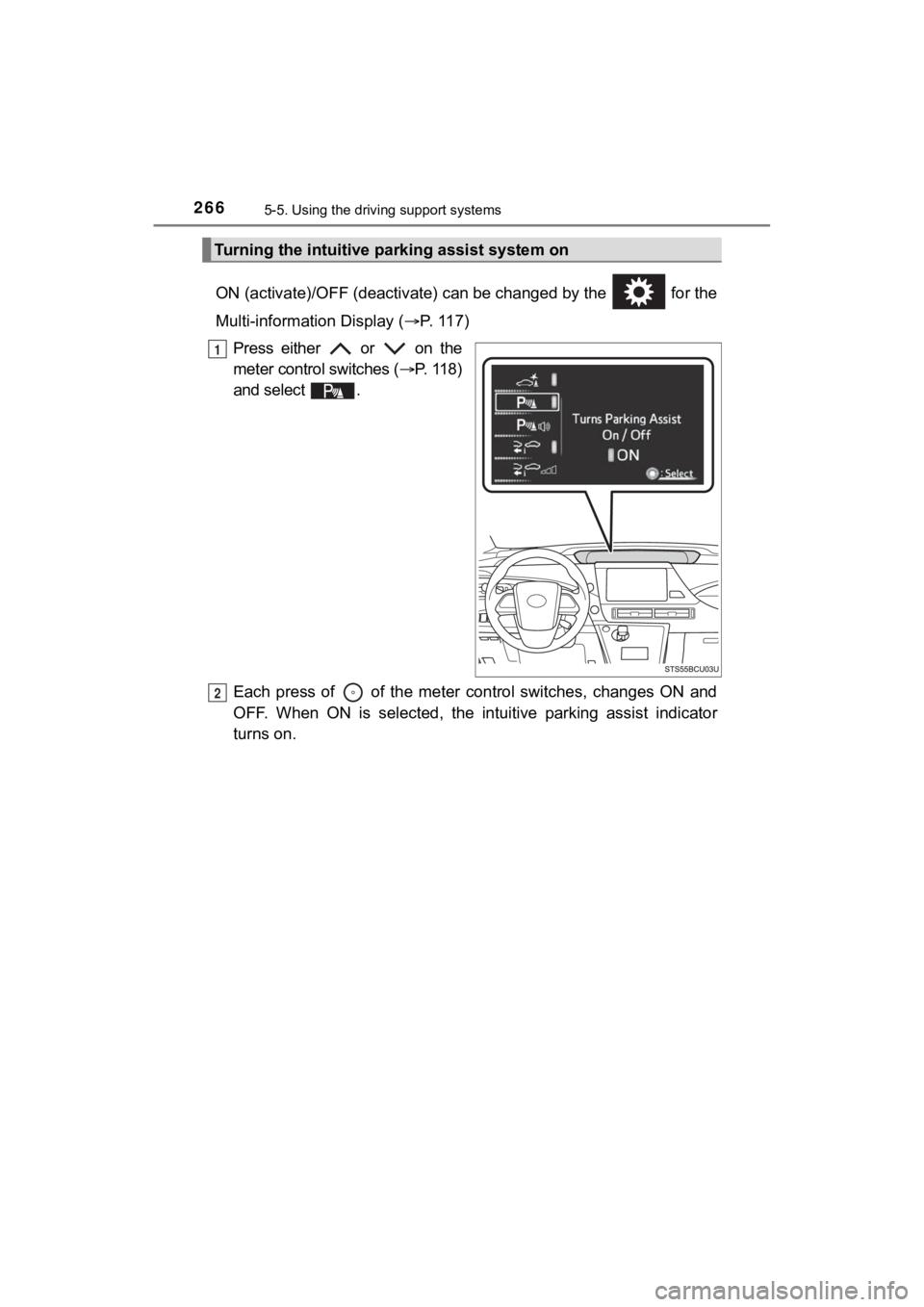
2665-5. Using the driving support systems
MIRAI_OM_USA_OM62073U
ON (activate)/OFF (deactivate) can be changed by the for the
Multi-information Display ( P. 117)
Press either or on the
meter contro l switches (P. 1 1 8 )
and select .
Each press of of the meter control switches, changes ON and
OFF. When ON is selected, the intuitive parking assist indicator
turns on.
Turning the intuitive pa rking assist system on
1
2
Page 267 of 528
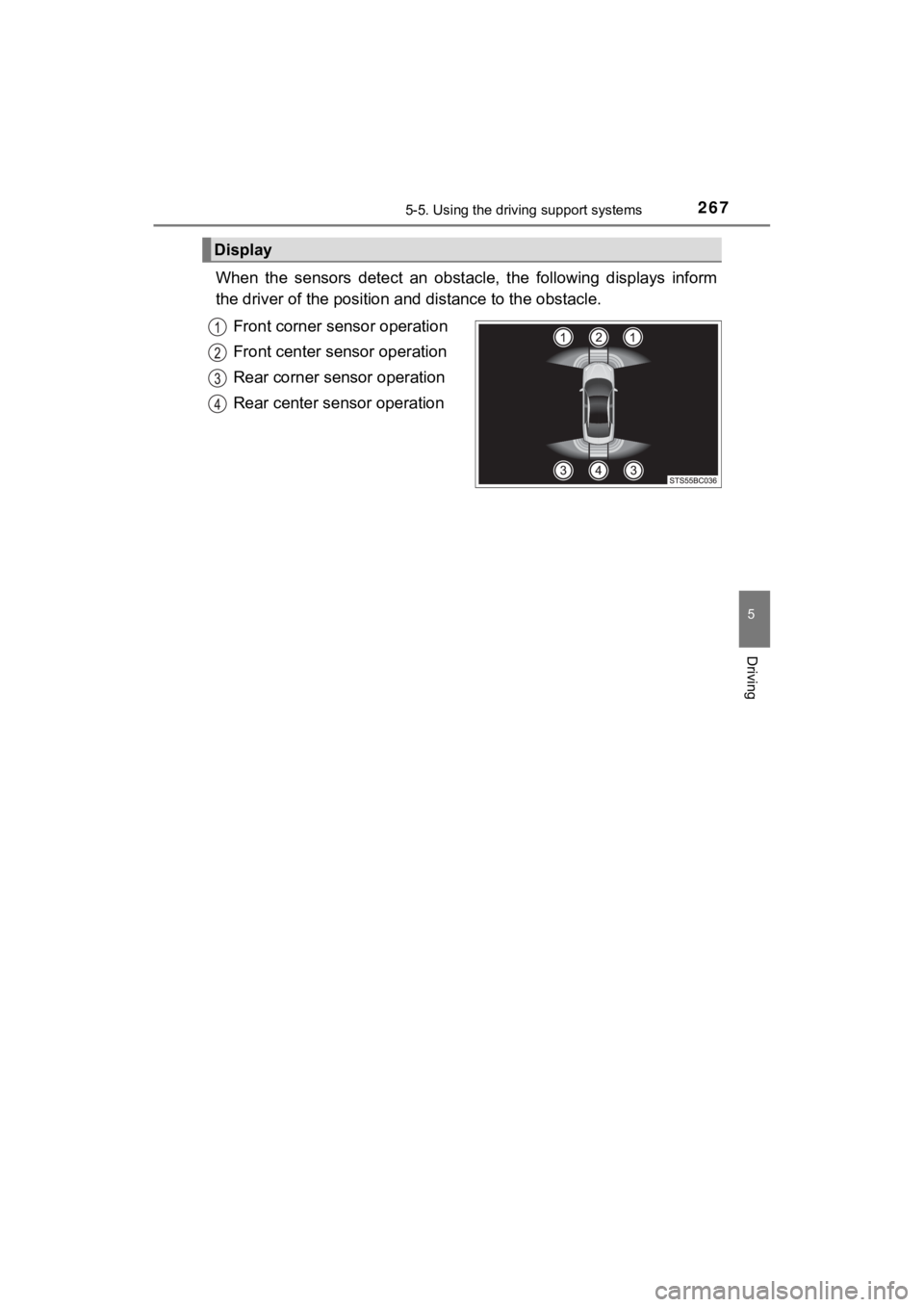
2675-5. Using the driving support systems
5
Driving
MIRAI_OM_USA_OM62073U
When the sensors detect an obstacle, the following displays inform
the driver of the position and distance to the obstacle.
Front corner sensor operation
Front center sensor operation
Rear corner sensor operation
Rear center sensor operation
Display
Page 268 of 528
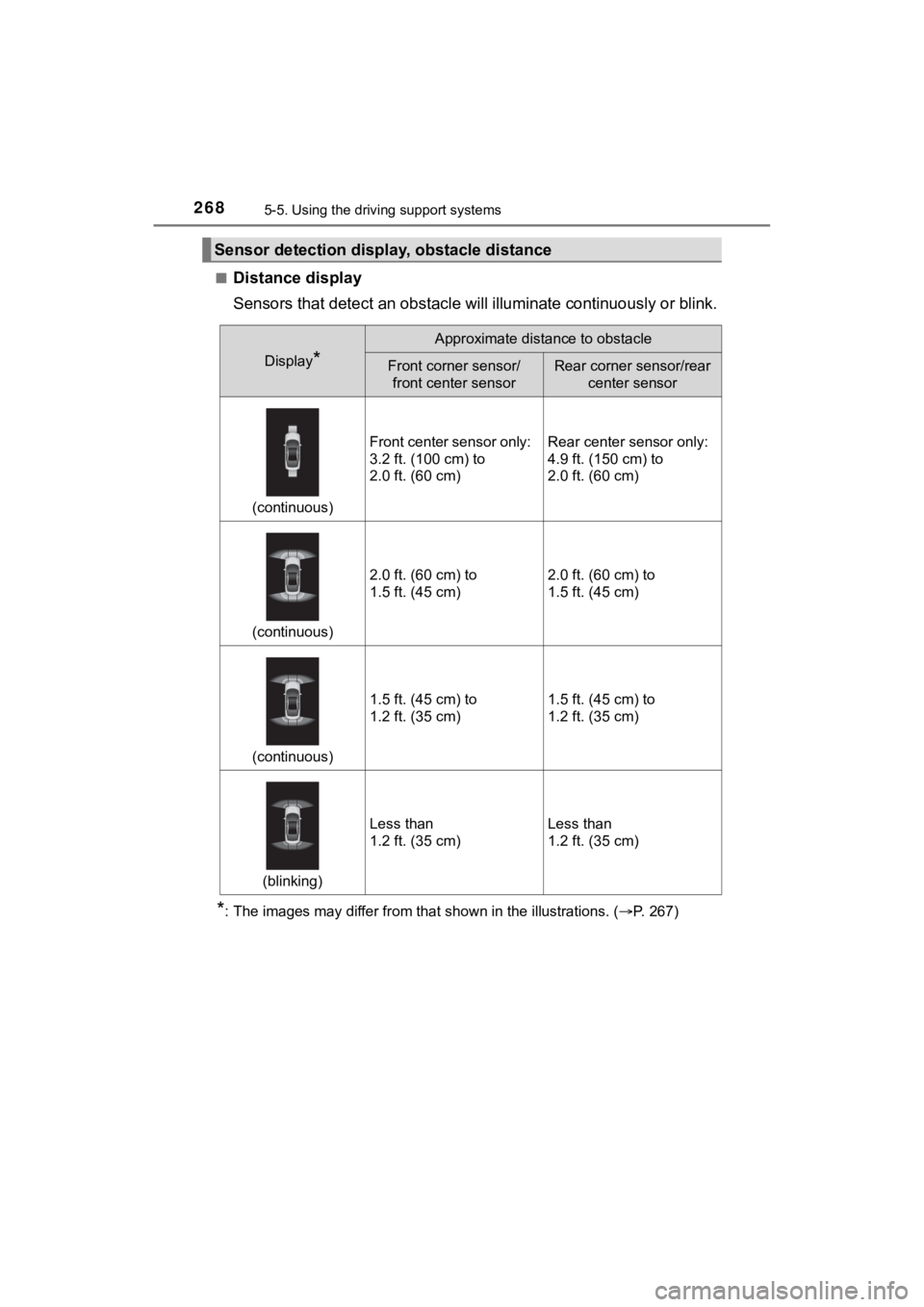
2685-5. Using the driving support systems
MIRAI_OM_USA_OM62073U■
Distance display
Sensors that detect
an obstacle will illuminate continuously or blink.
*: The images may differ from that shown in the illustrations. ( P. 267)
Sensor detection display, obstacle distance
Display*
Approximate distance to obstacle
Front corner sensor/
front center sensorRear corner sensor/rear center sensor
(continuous)
Front center sensor only:
3.2 ft. (100 cm) to
2.0 ft. (60 cm)Rear center sensor only:
4.9 ft. (150 cm) to
2.0 ft. (60 cm)
(continuous)
2.0ft.(60cm) to
1.5ft.(45cm)2.0 ft. (60 cm) to
1.5 ft. (45 cm)
(continuous)
1.5 ft. (45 cm) to
1.2 ft. (35 cm)1.5 ft. (45 cm) to
1.2 ft. (35 cm)
(blinking)
Less than
1.2 ft. (35 cm)Less than
1.2 ft. (35 cm)
Page 269 of 528
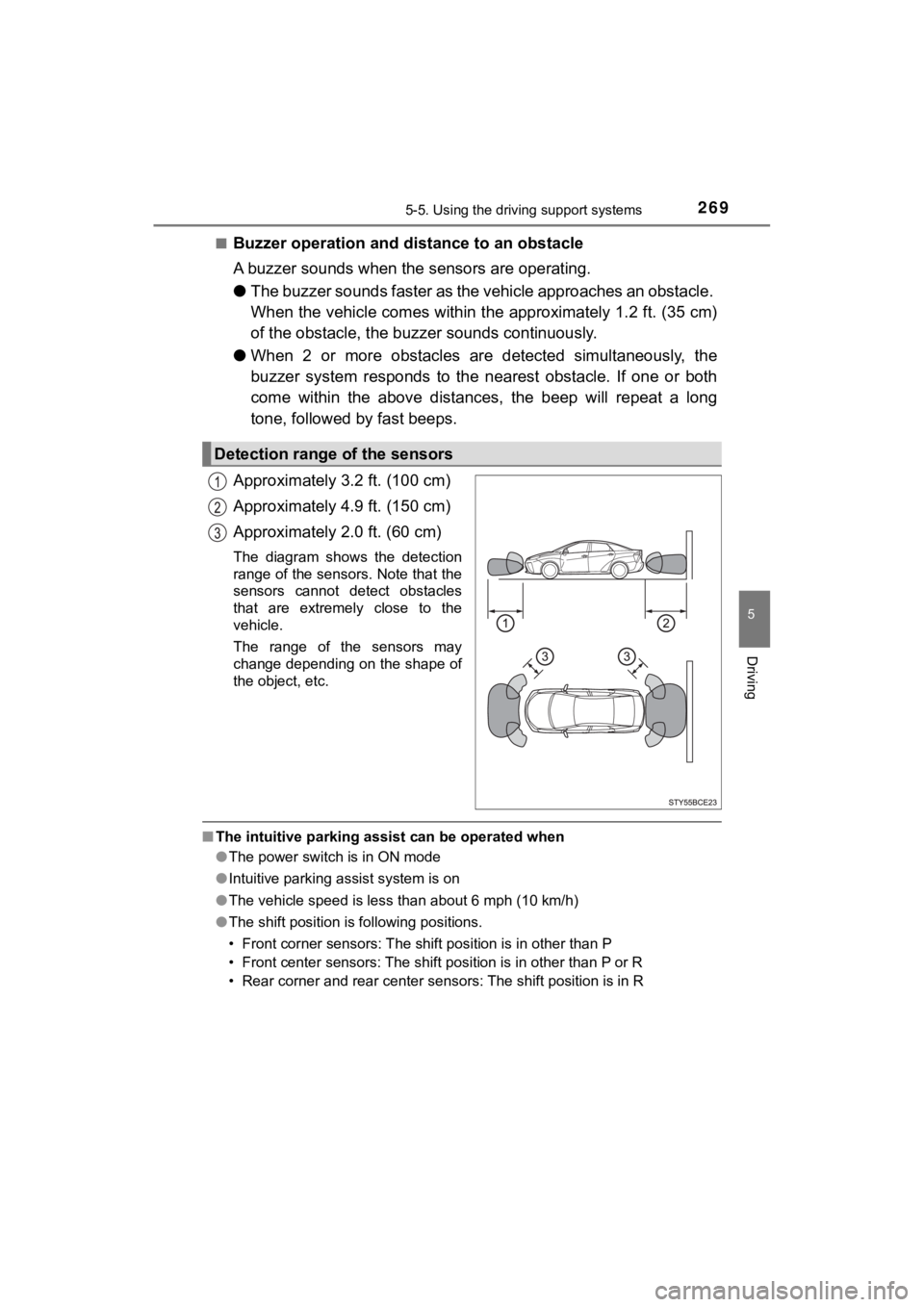
2695-5. Using the driving support systems
5
Driving
MIRAI_OM_USA_OM62073U■
Buzzer operation and di
stance to an obstacle
A buzzer sounds when the sensors are operating.
● The buzzer sounds faster as the vehicle approaches an obstacle.
When the vehicle comes within the approximately 1.2 ft. (35 cm)
of the obstacle, the buz zer sounds continuously.
● When 2 or more obstacles are detected simultaneously, the
buzzer system responds to the nearest obstacle. If one or both
come within the above distances , the beep will repeat a long
tone, followed by fast beeps.
Approximately 3.2 ft. (100 cm)
Approximately 4.9 ft. (150 cm)
Approximately 2.0 ft. (60 cm)
The diagram shows the detection
range of the sensors. Note that the
sensors cannot detect obstacles
that are extremely close to the
vehicle.
The range of the sensors may
change depending on the shape of
the object, etc.
■ The intuitive parking assist can be operated when
●The power switch is in ON mode
● Intuitive parking assist system is on
● The vehicle speed is less than about 6 mph (10 km/h)
● The shift position is following positions.
• Front corner sensors: The shift position is in other than P
• Front center sensors: The shift position is in other than P or R
• Rear corner and rear center sensors: The shift position is in R
Detection range of the sensors
Page 270 of 528

2705-5. Using the driving support systems
MIRAI_OM_USA_OM62073U■
Sensor detection information
●The sensor’s detection areas are limited to the areas around th e vehicle’s
bumper.
● Certain vehicle conditions and the surrounding environment may affect the
ability of a sensor to correctly detect an obstacle. Particular instances where
this may occur are listed below.
• There is dirt, snow or ice on the sensor. (Wiping the sensors will resolve
this problem.)
• The sensor is frozen. (Thawing the area will resolve this problem.)
In especially cold weather, if a sensor is frozen the screen ma y show an
abnormal display, or obstacles may not be detected.
• The sensor is covered in any way.
• The vehicle is leaning considerably to one side.
• On an extremely bumpy road, on an incline, on gravel, or on grass.
• The vicinity of the vehicle is noisy due to vehicle horns, motorcycle
engines, air brakes of large vehicles, or other loud noises pro ducing ultra-
sonic waves.
• There is another vehicle equipped with parking assist sensors in the
vicinity.
• The sensor is coated with a sheet of spray or heavy rain.
• The vehicle is equipped with a fender pole or wireless antenna .
• Towing eyelets are installed.
• The bumper or sensor receives a strong impact.
• A backlit license plate, license plate holder, etc., are insta lled.
• The vehicle is approaching a tall or curved curb.
• In harsh sunlight or intense cold weather.
• The area directly under the bumpers is not detected.
• If obstacles draw too close to the sensor.
• A non-genuine Toyota suspension (lowered suspension etc.) is i nstalled.
• People may not be detected if they are wearing certain types o f clothing.
In addition to the examples above, there are instances in which, because of
their shape, signs and other objects may be judged by a sensor to be closer
than they are.
● The shape of the obstacle may prevent a sensor from detecting i t. Pay par-
ticular attention to the following obstacles:
• Wires, fences, ropes, etc.
• Cotton, snow and other materials that absorb sound waves
• Sharply-angled objects
• Low obstacles
• Tall obstacles with upper sections projecting outwards in the direction of your vehicle